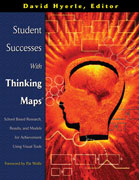



 dent Successes With Thinking Maps®
dent Successes With Thinking Maps®David Hyerle, editor with Sarah Curtis and Larry Alper co-editors
Chapter 2: Linking Brain Research to Best Practices
Chris Yeager, M.Ed.
Because thinking maps are a common visual language used by all teachers across grade levels, they become a familiar set of tools that make the learning process and patterns of information explicit and accessible to students. Teachers have reported a subtle distinction that has a lot of power: Students who work with the thinking maps feel safe when faced with challenging work because they have a set of tools for thinking that provide them with a structured framework within which to be creative. The level of fluency with the tools in Norm’s class offered students the opportunity to engage with each other and with the teacher’s complex questioning and final test without feeling threatened. With questions already linked within the thought processes of the thinking maps, students are, in fact, starting with these questions in mind. This invitation to learn, rather than the obligation to know, shifts the entire mood of the learning process. Not knowing is just not knowing yet. The automaticity of thinking permits novelty in content without a threat to the learner.
Thinking maps gave students a method and a structure that emphasized the relationships of pieces of information to each other. Because the patterns are embedded across the concept, recalling one bit of information on the map essentially fires the retrieval of the entire map. The more these patterns of thinking are rehearsed, the stronger and more efficient are the neural pathways for storage and retrieval of information in long-term memory. Thinking maps, visual tools which pattern information, support what the brain does naturally to process information by reflecting both its highly structured as well as its adaptive capacities to embed patterns within patterns.
Read the complete chapter in the book Student Successes With Thinking Maps. Key sections from the chapter Linking Brain Research to Best Practices with excerpts above include:
- Translating Theory into Practice
- Best Practices in the Classroom Context
- The Brain as a Visual Pattern Detector
- Meaning and Emotion
- Chunking and Mapping
- An Engaged and Elaborative Mind
Chris Yeager, M.Ed. is a former high school English teacher and school administrator who combines her 20 years of classroom experiences with current research in effective instruction and brain research to impact student achievement. She is the lead consultant for Innovative Learning Group and conducts Thinking Maps training nationally.
![]() Click here (pdf file) to download Research Highlights from
Click here (pdf file) to download Research Highlights from
Student Successes With Thinking Maps
For more on Student Successes With Thinking Maps go to the following links: